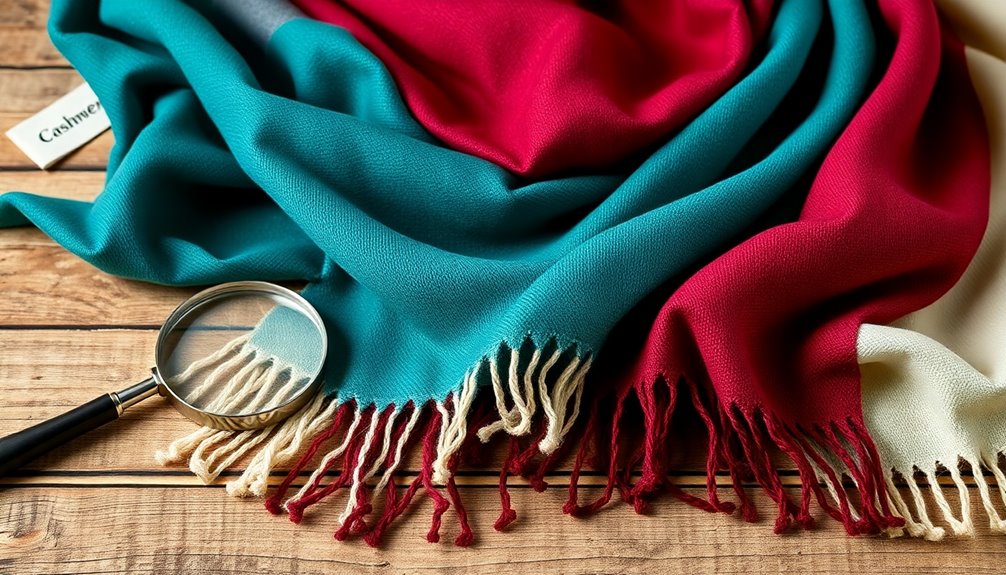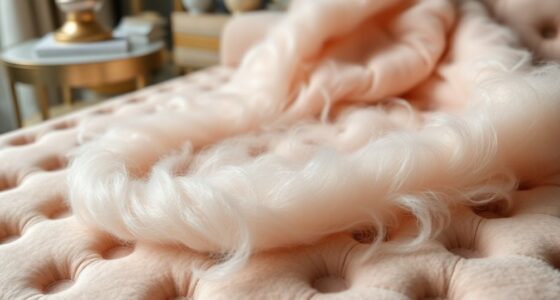Pashmina is a luxurious fabric known for its softness and warmth, made from the underbelly of the rare Changthangi goats found in the Himalayas. To spot genuine Pashmina, check for softness, look for slight irregularities in the weave, and feel for a lightweight texture. Be wary of overly shiny fabrics and low prices, as those often indicate fakes. If you want to guarantee you're making a wise purchase, there's much more to discover about authenticity.
Key Takeaways
- Pashmina, or "soft gold," is a luxurious fabric made from the underbelly fibers of the rare Changthangi goat in the Himalayas.
- Genuine Pashmina fibers measure 12 to 15 microns, making them softer than human hair, while fakes are often coarser than 19 microns.
- To identify authentic Pashmina, perform the softness test, burn test, and check for slight irregularities in weave and texture.
- Beware of red flags such as prices significantly below market average, lack of authenticity certificates, and glued labels instead of stitched ones.
- Supporting authentic Pashmina preserves artisan livelihoods, protects cultural heritage, and promotes ethical fashion practices against the spread of counterfeit products.
The Allure of Pashmina: A Luxurious Fabric
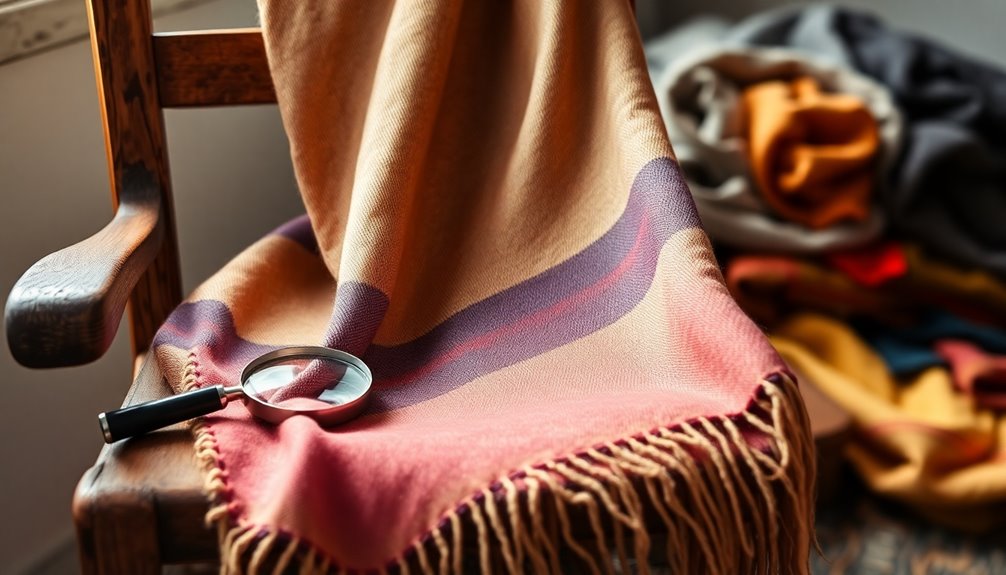
Pashmina, often called "soft gold," captivates with its luxurious feel and warmth. This exquisite fabric, derived from the underbelly of the rare Changthangi goat, offers an unparalleled softness that you'll immediately appreciate.
When you wrap yourself in genuine Pashmina, you experience not just comfort but also a connection to rich cultural heritage and exceptional craftsmanship.
Authenticity matters, as the superior quality of real Pashmina justifies its premium price. However, be cautious of counterfeit products that exploit its allure.
These fakes often use synthetic materials, failing to replicate the unique softness and warmth of genuine Pashmina. Knowing how to identify authentic pieces guarantees you invest wisely in this luxurious fabric that elevates any wardrobe.
Understanding the Source: Cashmere Wool and Changthangi Goats
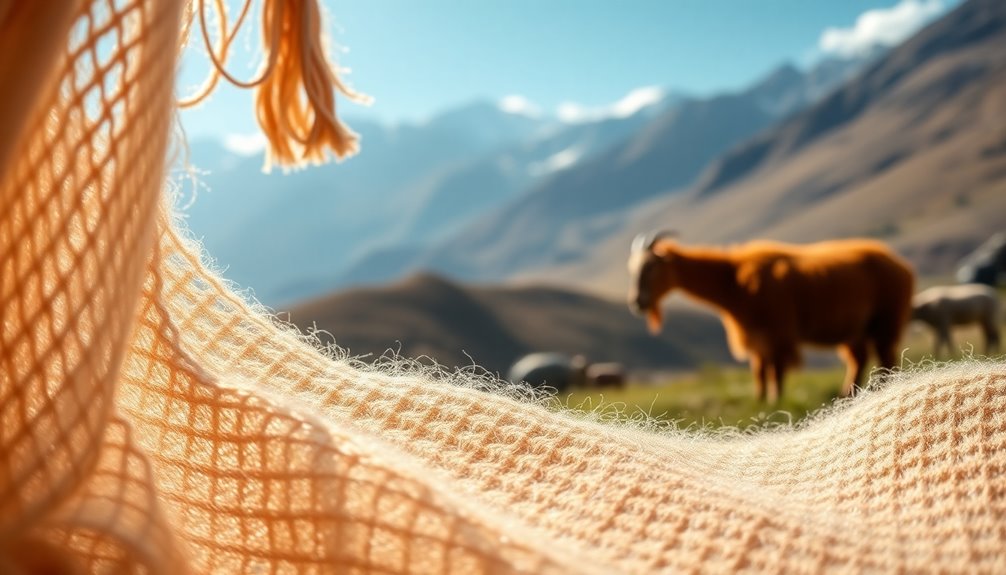
To truly appreciate Pashmina, you need to understand the unique characteristics of Changthangi goats and the exceptional cashmere wool they produce.
These goats, native to harsh Himalayan climates, yield only a small amount of fine wool each year, making Pashmina a rare treasure.
The regional significance of this craft not only highlights its exclusivity but also showcases the traditional skills involved in processing this luxurious material.
Changthangi Goat Characteristics
The Changthangi goat, renowned for its exquisite cashmere wool, thrives in the harsh climates of the Himalayas, particularly in Ladakh and Kashmir.
This unique breed, also known as the Pashmina goat, produces cashmere wool with an exceptional quality, featuring fibers that range from 12 to 15 microns in diameter—softer than human hair.
The underbelly is the primary source of this fine wool, as it collects delicate fibers during the spring molting season.
Due to their rarity and the challenging environment, Changthangi goats yield only a small quantity of wool each year, enhancing the exclusivity of genuine Pashmina.
The traditional production process reflects centuries of craftsmanship, ensuring that each item retains its rich heritage and unmatched quality.
Cashmere Wool Qualities
Cashmere wool, celebrated for its luxurious feel, comes from the underbelly of the Changthangi goat, a breed uniquely adapted to the harsh Himalayan climate.
This wool boasts an exceptional softness, with fibers measuring just 12 to 15 microns in diameter, making it softer than human hair.
The rarity of cashmere is highlighted by the limited production, with each goat yielding only around 80 grams annually.
Authentic Pashmina products showcase not only this exquisite softness but also impressive insulating properties, offering warmth without bulk.
The meticulous craftsmanship involved in collecting, spinning, and weaving the fibers guarantees high-quality items, making every piece truly special.
Investing in authentic Pashmina means embracing the unparalleled qualities of cashmere from these remarkable goats.
Regional Production Significance
While exploring the world of Pashmina, understanding its regional production significance is essential.
Pashmina wool comes from the soft underbelly of Changthangi goats, native to the harsh, high-altitude regions of the Himalayas, particularly in Kashmir, India, and Nepal. The unique climate nurtures these goats, making genuine Pashmina a rare luxury.
Each goat produces only 80 to 200 grams of Pashmina wool annually, highlighting its scarcity and value. The production process is deeply tied to the cultural heritage of the region.
Local artisans utilize traditional techniques, passed down through generations, to craft exquisite products.
Common Types of Fake Pashmina and Their Characteristics
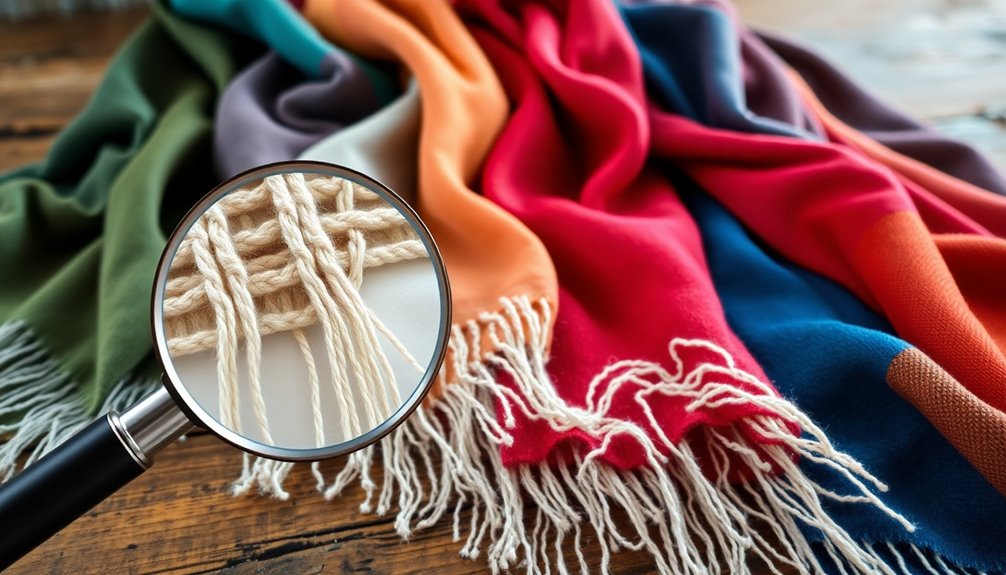
When you're shopping for Pashmina, watch out for synthetic fiber imitations like polyester and acrylic blends.
These counterfeits often feel heavy and coarse, lacking the lightweight softness of authentic Pashmina.
You might also notice an unnatural sheen or uniform texture, which are telltale signs that you're looking at a mass-produced fake.
Synthetic Fiber Imitations
Synthetic fibers are often the go-to choice for counterfeit Pashmina, with polyester and acrylic leading the pack.
These fake Pashmina products often compromise quality and authenticity. While authentic Pashmina fibers are soft and warm, synthetic versions can feel scratchy and bulky, lacking the luxurious comfort of the real thing.
You'll notice that genuine Pashmina is lightweight and provides excellent insulation, whereas synthetic alternatives fall short in both feel and function.
Additionally, synthetic fibers wear out more quickly than authentic Pashmina, which boasts durability and longevity when cared for properly.
Even if acrylic blends mimic the look of Pashmina, they can't replicate the unique quality that defines genuine Pashmina.
Always choose wisely to guarantee you're investing in the real deal.
Common Characteristics of Counterfeits
Counterfeit Pashmina often shares several distinct characteristics that can help you identify a fake.
Most fakes are made from synthetic imitations like polyester or acrylic, lacking the unmatched quality and softness of genuine Pashmina.
While authentic Pashmina fibers have a fine diameter of 12 to 15 microns, fakes usually exceed 19 microns, making them feel coarser.
You may also notice a shiny appearance in counterfeits due to synthetic materials, whereas a genuine Pashmina scarf has a matte finish.
Additionally, imitations often have uniform weaving patterns, while real Pashmina showcases slight irregularities from handcrafting.
Finally, if a scarf generates static electricity when rubbed, it's a sure sign you've spotted a fake during your Pashmina purchase.
The Importance of Consumer Knowledge and Empowerment
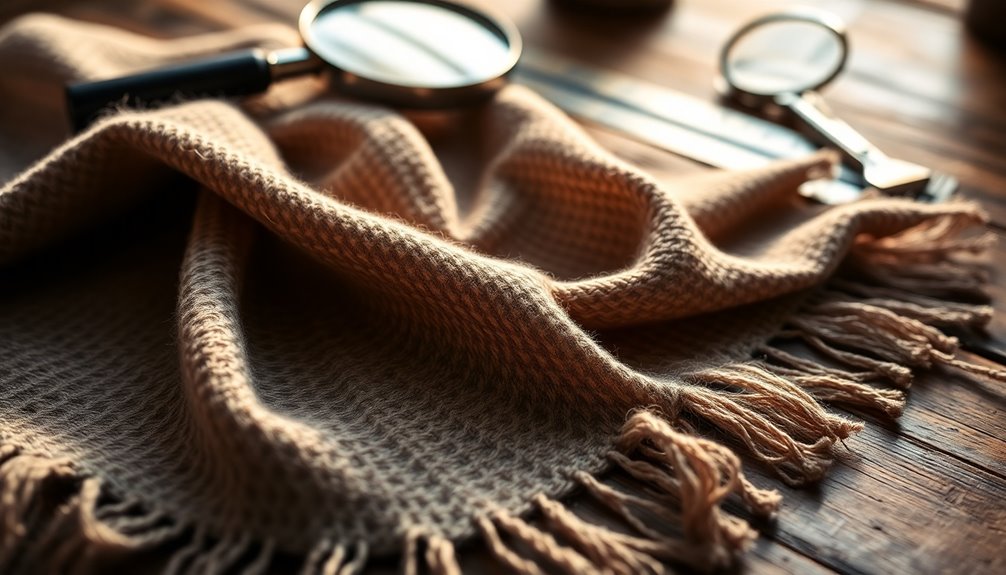
Understanding the nuances of authentic Pashmina not only empowers you as a consumer but also enhances your purchasing experience.
By learning about genuine Pashmina, you're equipped to make informed decisions that support traditional craftsmanship and the artisans who create these luxurious items.
- Discover the softness and durability that define authentic Pashmina.
- Appreciate the rarity sourced from the underbelly of Changthangi goats.
- Avoid the disappointment of counterfeit Pashmina that imitates quality.
- Support communities that rely on the sale of genuine products.
- Preserve cultural heritage by choosing authentic items over fakes.
With knowledge of the characteristics of authentic Pashmina, you can confidently navigate the luxury market and guarantee your investment truly reflects quality and authenticity.
Essential Tests to Identify Genuine Pashmina
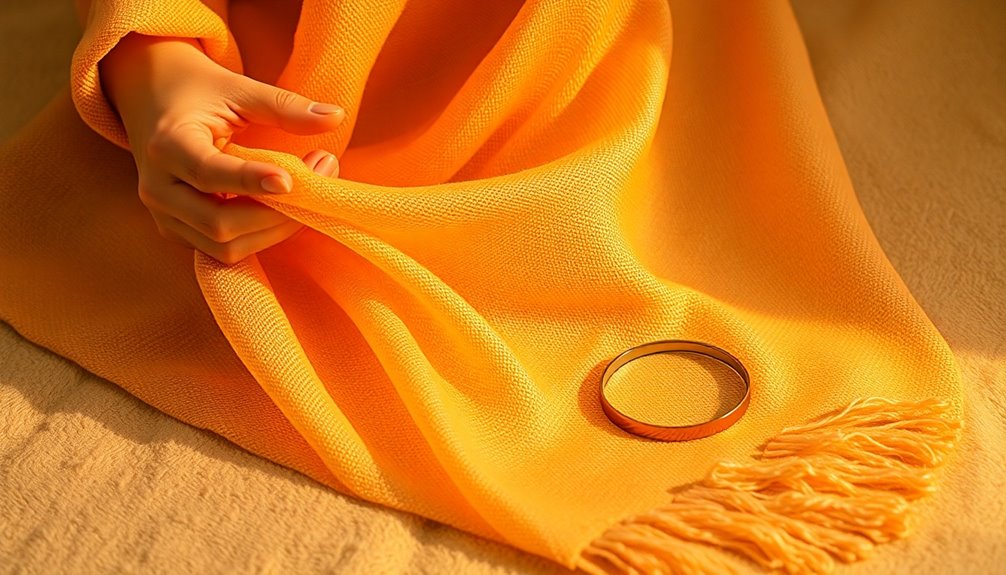
Now that you're equipped with knowledge about authentic Pashmina, it's time to put that information to practical use. Here are essential tests to help you identify genuine Pashmina:
| Test | Genuine Pashmina | Synthetic Fibres |
|---|---|---|
| Softness Test | Incredibly smooth, butter-like | Scratchy, uncomfortable |
| Burn Test | Emits burnt hair smell, leaves powdery ash | Produces chemical odor, shrinks or melts |
| Transparency | Doesn't transmit light, no shine | Shiny, light-transmitting |
| Weave Irregularity | Slight variations from handcrafting | Uniform texture, lacks uniqueness |
| Static Test | Remains static-free when rubbed | Attracts dust, creates sparks |
Using these tests will help you in spotting fake Pashmina while ensuring the warm and softness you desire.
Label and Tag Indicators for Authenticity
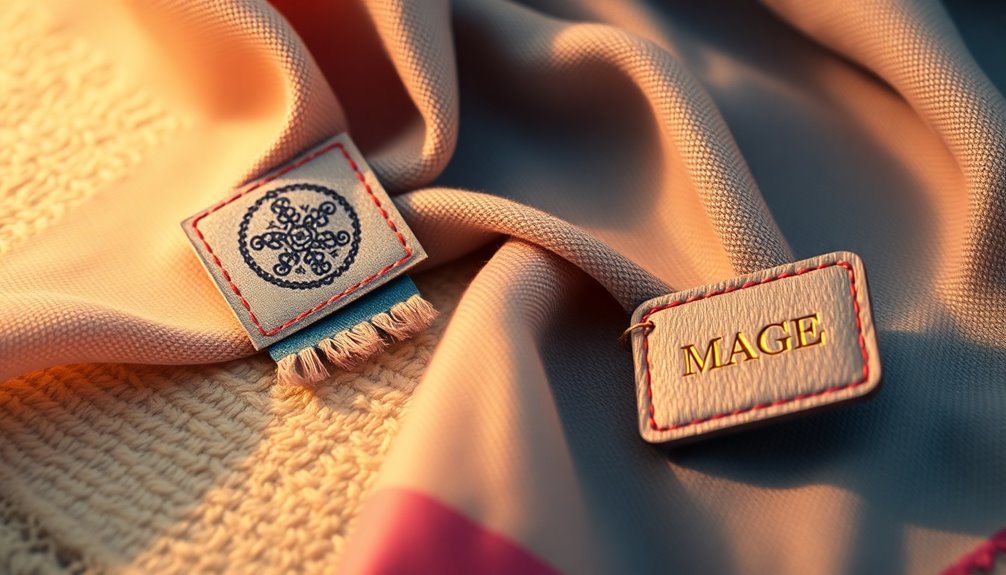
When it comes to identifying authentic Pashmina, paying attention to labels and tags is essential. Genuine Pashmina products feature stitched labels, which represent superior craftsmanship.
Look for labels that specify the cashmere percentage; if it's missing, be cautious. Quality matters—cheap, flimsy tags often signal a counterfeit product.
Always buy from reputable sellers who provide authenticity certificates from recognized organizations.
- Stitched labels exude quality
- Cashmere percentage assures authenticity
- Flimsy tags raise red flags
- Authenticity certificates provide peace of mind
- Low prices often mean fake Pashmina
Physical Characteristics of Real Pashmina

To spot real Pashmina, you should focus on its unique physical characteristics.
Genuine Pashmina is incredibly soft, with a fiber diameter of 12 to 15 microns, making it softer than human hair. You'll notice its matte finish, lacking the excessive shine that often signals a counterfeit.
The texture is buttery soft and lightweight, allowing it to drape elegantly without clinging or feeling heavy. Look for slight irregularities in the weave; these imperfections indicate meticulous handcrafting, unlike machine-made fakes that are overly uniform.
When you touch authentic Pashmina, it should feel warm and breathable, providing insulation without bulk, a quality that sets it apart from thicker, synthetic alternatives.
Retailer and Seller Red Flags to Watch For
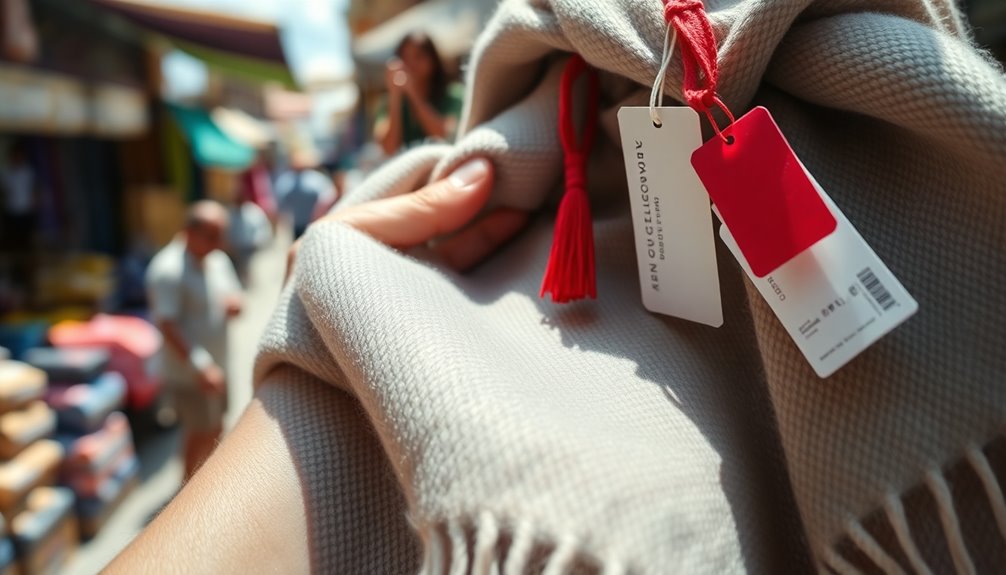
Identifying red flags in retailers and sellers can save you from purchasing fake Pashmina. When shopping, keep an eye out for these warning signs:
- Retailers offering prices far below the market average
- Sellers without authenticity certificates from recognized organizations
- Vendors lacking customer reviews or a solid reputation
- Labels that are glued instead of stitched, indicating inferior quality
- Retailers who can't provide clear information about the product's origin
Trustworthy retailers prioritize authenticity and transparency.
Genuine Pashmina commands a premium price due to its craftsmanship. If something feels off, it likely is. Protect yourself by being vigilant and choosing reputable sellers who stand behind their products.
The Consequences of Fake Pashmina on Communities
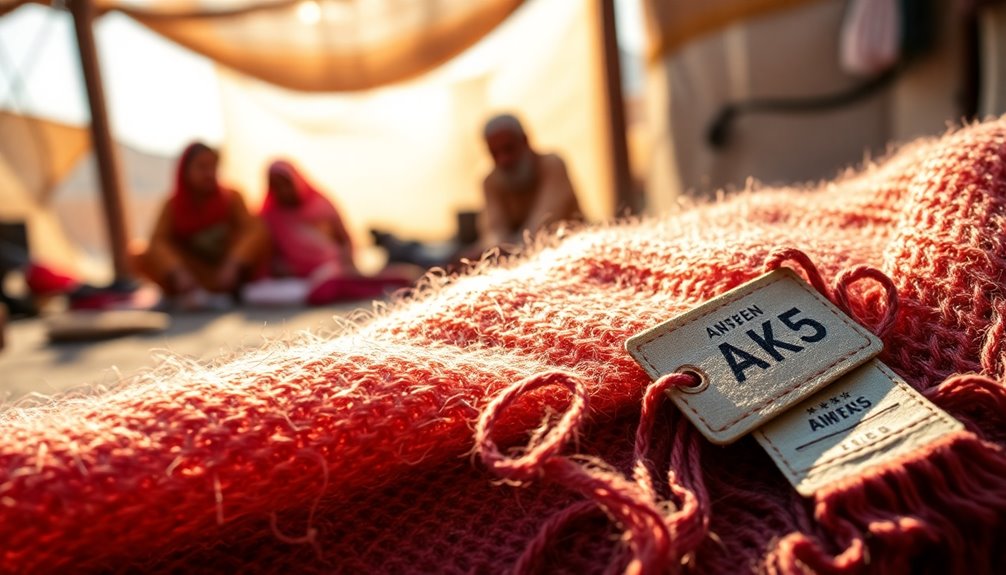
Fake Pashmina isn't just a personal loss for buyers; it has far-reaching consequences for communities, particularly in regions like Kashmir. The rise of fake Pashminas jeopardizes local communities dependent on authentic Pashmina production. It leads to job losses, reduced income, and threatens the cultural heritage tied to artisan craftsmanship. Additionally, counterfeit production often exploits vulnerable workers, including children, further damaging the social fabric of these communities.
| Consequence | Impact on Communities |
|---|---|
| Job Losses | Decreased income for artisans |
| Cultural Heritage Damage | Undermines value of genuine artistry |
| Exploitation in Labor | Increases unethical practices |
Supporting authentic Pashmina is essential for preserving rich traditions and ensuring sustainable economic benefits.
Supporting Authentic Pashmina: Preserving Tradition and Craftsmanship
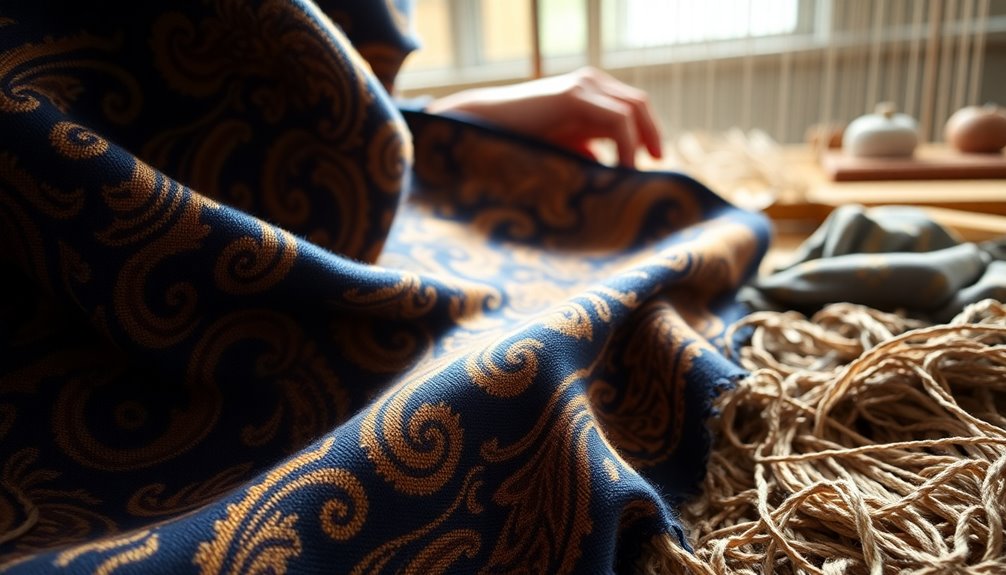
When you choose authentic Pashmina, you're not just buying a luxurious textile; you're supporting the livelihoods of skilled artisans and preserving their cultural heritage.
This commitment to ethical fashion practices helps guarantee that traditional craftsmanship thrives in the face of counterfeit goods.
Impact on Artisans' Livelihoods
Supporting authentic Pashmina is crucial for preserving the livelihoods of artisans who rely on this craft for their income. When you choose genuine Pashmina, you help sustain traditional craftsmanship and guarantee artisans are fairly compensated for their hard work.
Counterfeit Pashmina threatens this delicate balance by flooding the market with inferior products, reducing demand for true artistry.
- Each authentic piece tells a story of skill and dedication.
- Artisans invest weeks of labor into every item.
- Families depend on this income for their survival.
- Traditional weaving techniques risk fading away.
- Economic stability in local communities hangs in the balance.
Cultural Heritage Preservation
Authentic Pashmina is more than just a luxurious fabric; it embodies a rich cultural heritage that has been lovingly preserved through generations.
By choosing genuine Pashmina, you support traditional craftsmanship rooted in the artistry of skilled artisans who rely on the rare Changthangi goat for its fine wool. This material's cultural significance is immense, reflecting the history and identity of communities in Kashmir.
However, counterfeit Pashmina threatens these artisans' livelihoods and undermines their hard work. By investing in authentic products, you promote ethical practices and guarantee sustainable artisanal practices continue to thrive.
Supporting genuine Pashmina not only enriches your wardrobe but also helps preserve this exquisite textile's artistry for future generations.
Ethical Fashion Practices
Choosing genuine Pashmina not only enhances your wardrobe but also champions ethical fashion practices that preserve tradition and craftsmanship. By opting for authentic pieces, you support the artisans of Kashmir, ensuring they thrive under fair labor conditions.
This commitment helps maintain the cultural heritage of traditional craftsmanship passed down through generations.
Consider the impact of your choices:
- Sustain livelihoods of skilled artisans
- Promote fair wages and working conditions
- Protect cultural heritage and artisanal skills
- Combat the spread of counterfeit Pashmina
- Advocate for sustainable practices that reduce waste
When you invest in genuine Pashmina, you're not just buying a scarf; you're embracing a meaningful legacy that uplifts communities and fosters environmental responsibility.
Frequently Asked Questions
How Do You Know if Pashmina Is Real?
To know if Pashmina's real, start by feeling the fabric; it should be incredibly soft and smooth, not itchy at all.
Pinch it gently—authentic Pashmina compresses easily and springs back.
You can also perform a burn test; genuine Pashmina burns slowly, smelling like burnt hair, and leaves powdery ash.
Finally, check for labels confirming cashmere content and any quality assurance certificates to guarantee you're getting the real deal.
Why Is Pashmina Banned in Usa?
You might think Pashmina is just a luxurious fabric, but it's actually banned in the USA due to serious ethical concerns.
The U.S. aims to protect endangered species, particularly the Changthangi goats that produce this wool.
Regulations require proof of ethical sourcing to prevent illegal trade.
If you're considering a Pashmina purchase, you'll need to guarantee it's sourced responsibly to avoid legal issues and support sustainable practices.
What Is so Special About Pashmina?
Pashmina's truly special because it combines luxurious softness with exceptional warmth, making it a perfect accessory for chilly days.
You'll appreciate its lightweight feel, which provides comfort without bulk.
The unique hand-weaving process gives each piece a distinct character, showcasing traditional craftsmanship that's hard to replicate.
Plus, owning Pashmina connects you to a rich cultural heritage and supports artisans in regions like Kashmir, adding even more value to your purchase.
What Is the Difference Between Pashmina and Faux Pashmina?
When you compare Pashmina to faux Pashmina, you'll notice several key differences.
Genuine Pashmina, made from Changthangi goat wool, feels incredibly soft and luxurious, while faux options often use synthetic materials, resulting in a coarser texture.
Real Pashmina is lighter yet warmer, whereas faux versions tend to be heavier and less insulating.
Additionally, the price of authentic Pashmina is usually higher, reflecting its quality and craftsmanship, so keep an eye on those details.
Conclusion
When you wrap yourself in the warmth of genuine pashmina, you're not just draping a luxurious fabric; you're embracing a rich heritage woven by skilled hands. By knowing how to spot the real deal, you're safeguarding traditions and supporting artisans who pour their heart into every thread. So, let your choice be a celebration of authenticity, where each soft embrace tells a story, and every color reflects the vibrant culture of its origin. Choose wisely, cherish deeply.
